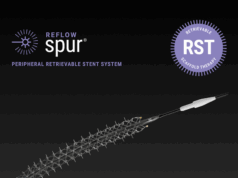
A new analysis of chronic limb-threatening ischaemia (CLTI) treatment outcomes was presented today as late-breaking clinical research at the Society for Cardiovascular Angiography & Interventions (SCAI) 2023 Scientific Sessions (18–20 May, Phoenix, USA), a press release reports.
Following the initial results of the BEST-CLI (Best endovascular versus best surgical therapy in patients with critical limb ischaemia) trial in 2022, which found surgical intervention superior to endovascular revascularisation, questions remained regarding how inclusive the enrolled patient population was, how reflective the specialty of the physicians who performed the procedures are compared to the broader breakdown of US specialists performing peripheral procedures, and whether outcome rates are similarly observed in clinical practice among Medicare beneficiaries.
The BEST-CLI trial compared two CLTI treatment options, endovascular revascularisation and surgical bypass to understand which approach leads to better outcomes. While the study found surgical revascularisation to be superior, the generalisability of this study to the clinical population with CLTI has not been evaluated.
The new study sought to analyse a broader clinical population by identifying all Medicare beneficiaries between 2016–2019 and aged 65–85 years with a diagnosis of CLTI who underwent endovascular or surgical revascularisation. Revascularisation was stratified by endovascular, autologous graft, and non-autologous graft. The endpoint was a composite of major adverse limb events (MALE) and death.
A total of 66,153 patients were included in this study (10,125 autologous graft; 7,867 non-autologous graft; 48,161 endovascular). Compared to BEST-CLI Cohort 1, patients were older, more often female and had a greater burden of comorbidities. Endovascular operators for the study population versus BEST-CLI were less likely to be surgeons (55.9% vs. 73.0%) and more likely to be interventional cardiologists (25.5% vs. 13.0%). The risk of death or MALE in this cohort was higher with surgery (56.6% autologous grafts vs. 42.6% BEST-CLI Cohort 1; 51.6% non-autologous grafts vs. 42.8% BEST-CLI Cohort 2) but similar with endovascular (58.7% real-world vs. 57.4% Cohort 1; 47.0% real-world vs. 47.7%). Of those receiving endovascular treatment, major interventions occurred less frequently compared to the trial (10.0% real-world vs. 23.5% Cohort 1; 8.6% real-world vs. 25.6% Cohort 2).
“For critical limb ischaemia, the key is ensuring timely access to vascular care. Although the BEST-CLI trial is important, it does not fully capture the full range of CLI patients, including older patients with greater comorbidities,” said Eric A Secemsky (Beth Israel Deaconess Medical Center, Boston, USA), the study lead, in a SCAI press release. “The findings from our study point to the need to individually tailor revascularisation strategies based on patient risks, benefits and preferences.”
The authors note that older CLTI patients may not experience the same benefit with bypass surgery as observed in BEST-CLI where at the time, fewer Medicare patients were enrolled in the trial.










